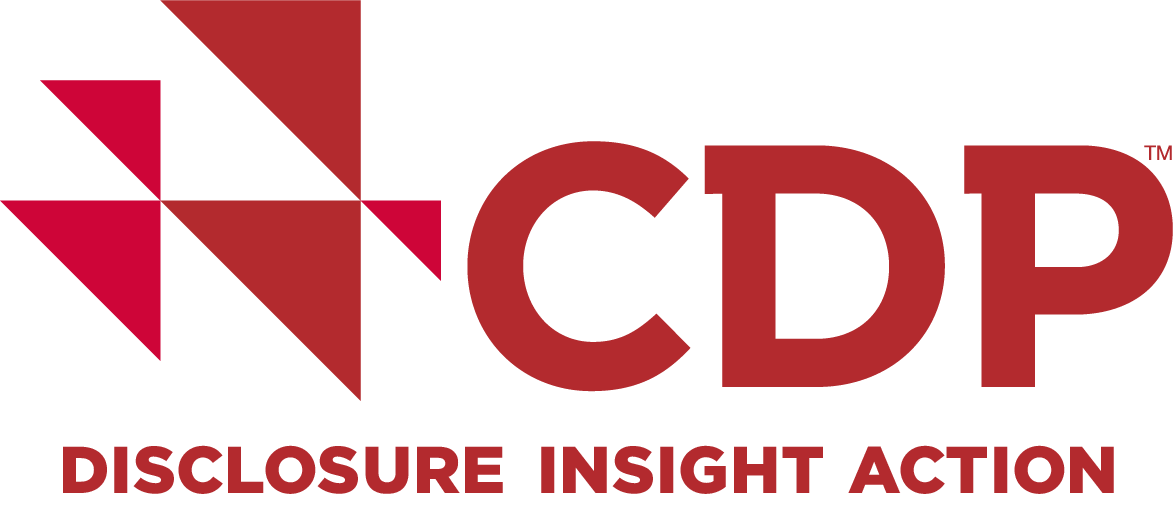Climate-Related Disclosures based on the TCFD
Disclosure of Climate Change-Related Information in line with the TCFD Recommendations
TOA CORPORATION regards climate change as one of its most material issues, in December 2021, expressed its support for the final recommendations of the Task Force on Climate-related Financial Disclosures (TCFD).
TCFD is the international initiative established in 2015 by the G20 Financial Stability Board (FSB) to improve the disclosure of information on the financial impact of climate-related risks and opportunities.
The TOA CORPORATION Group discloses climate-related information in accordance with these TCFD recommendations.

Thematic areas of Climate-Related Disclosures by TCFD recommendations
| Governance | The organization’s governance around climate-related risks and opportunities |
|---|---|
| Risk management | The processes used by the organization to identify, assess, and manage climate-related risks |
| Strategy | The actual and potential impacts of climate-related risks and opportunities on the organization’s businesses, strategy, and financial planning |
| Metrics and targets | The metrics and targets used to assess and manage relevant climate-related risks and opportunities |
■Governance
The ESG Committee has been established to promote company-wide ESG activities of the TOA CORPORATION Group. The committee is chaired by the president and consists of one vice president, six general managers, a director who is a full-time audit committee member, and an outside director who is an audit committee member.
The ESG Committee meets twice a year to formulate basic policies and specific action plans concerning ESG activities, including responses to climate change, review the results of activities, and discuss measures. The results of the committee's deliberations are reported to the Board of Directors, and important decisions are communicated to business divisions (including branches) and group companies to establish a group-wide governance system. In the future, TOA CORPORATION will aim to share the policies and the plans related to ESG with partner companies.
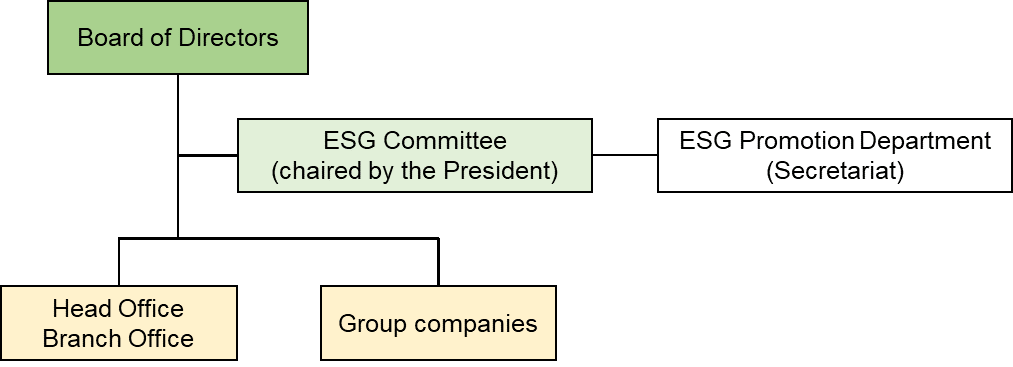
■Risk management
The policies and systems for risk management of the TOA CORPORATION Group, including climate change, are deliberated by the "ESG Committee". In classifying risks and opportunities, including climate-related risks, we organize the possible events and impacts of each, and evaluate them based on "frequency of occurrence" and "impact of occurrence". For each risk and opportunity item, a lead department is established, and preventive measures are discussed. The Group's material risks and opportunities determined through these processes are discussed and approved by the ESG Committee and reported to the Board of Directors. The material risks determined by the ESG Committee are integrated into the Company's management strategy and other relevant documents.
The Board of Directors receives reports on climate change-related matters from the ESG Committee and oversees the progress of efforts to address climate change-related issues.
■Strategy
Based on the TCFD recommendations, scenario analyses were conducted to identify and evaluate risks and opportunities in our group and to understand the impact of climate-related issues on our business, taking all perspectives into account: short term (3 years), medium term (10 years), and long term (30 years).
In considering risks and opportunities related to "transition to a decarbonized society" and "physical change due to climate change", the following representative scenarios are adopted.
- Transition Scenario: Among the scenarios developed by the International Energy Agency (IEA), we used a scenario "NZE2050". This is a scenario in which net zero emissions will be achieved in 2050 to limit the temperature increase at the end of this century to less than 1.5°C compared to pre-industrial period. The results of this analysis include a review of the analysis of the Sustainable Development Scenarios "SDS" developed by the IEA.
- Physical Scenario : We used a scenario "RCP8.5" in which the temperature-rise at the end of this century will exceed 4°C compared with the pre-industrial period, developed by the Intergovernmental Panel on Climate Change (IPCC).
Based on these results, we are strategically addressing the following issues as specific responses and are maximizing business opportunities while limiting negative financial impact.
- Reducing CO₂ emissions at the construction stage (energy-saving construction, productivity improvement, introduction of low-carbon construction equipment and fuels, procurement of electricity from renewable energy sources, R&D on low-carbon concrete, and R&D on CO₂ capture and utilization technologies, etc.)
- Promoting ZEB/ZEH in buildings (registration as a ZEB Planner/ZEB Leading Owner)
- Initiative for participating in offshore wind power generation projects (shipbuilding of self-elevating platform, and R&D for construction of floating type facilities)
- R&D of technologies that contribute to disaster prevention/mitigation and renewal of infrastructure
- R&D of technologies for the creation of blue carbon
| Classification | Risks / Opportunities | Impacts | Impact level | Countermeasures | |
|---|---|---|---|---|---|
| Transition scenarios | Risks | Introduction of carbon tax and strengthening regulations for decarbonization |
|
Large |
|
| Changes in the energy mix |
|
Medium |
|
||
| Opportunities | Growing demand for environmentally friendly buildings |
|
Large |
|
|
| Increased demand for carbon-neutral facilities |
|
Large |
|
||
| Increased demand for renewable energy |
|
Large |
|
||
| Growing demand for creation of Blue Carbon |
|
Medium |
|
||
| Improvement of evaluation against the efforts for climate change |
|
Medium |
|
||
| Physical scenarios | Risks | Increase in the average temperature |
|
Large |
|
| Aggravation of natural disasters |
|
Medium |
|
||
| Opportunities | Market changes associated with climate change |
|
Large |
|
|
| Increased construction demand due to sea level rise |
|
Large |
|
||
■Metrics and targets
We have established key performance indicators (KPIs) for ESG-related initiatives and monitor their status. As one of KPIs, we have set the total greenhouse gas emissions (Scope 1+2 and Scope 3) as metrics, and established its reduction target based on SBT, in consideration of the impact of future climate-related risks and opportunities. These had certified as WB2°C target by the SBT initiative in September 2022. In addition, for Scope 1+2, Net Zero target by FY2050 was set in March 2023. We are managing the total amount of greenhouse gas emissions as a direct parameter affected by climate-related risks and opportunities and promote specific reduction measures.
| Total emissions Scope1+2 |
More than 25% cut in FY2030 (Compared to FY2020) * Net Zero by 2050 |
|---|---|
| Total emissions Scope3 |
More than 25% cut in FY2030 (Compared to FY2020) * |
* The above targets were approved by SBT initiative as Science Based Targets (WB2°C targets) on September 2022.
(Reference) Explanation of terms
- SBT (Science Based Targets)
Greenhouse gas emission reduction targets set by companies, consistent with the levels required by the Paris Agreement. - Paris Agreement
An international agreement on greenhouse gas reductions agreed by Conference of the Parties (COP) to the United Nations Framework Convention on Climate Change (UNFCCC) in Paris in 2015. The common long-term global goals are: (1) to keep the global average temperature increase well below 2°C above pre-industrial levels and to limit it to 1.5°C; and (2) to peak out global greenhouse gas emissions as soon as possible to achieve a balance between emissions and absorption (by forests, etc.) in the second half of the 21st century. - SBTi (Science Based Targets initiative)
An international initiative encouraging companies to set greenhouse gas emission reduction targets consistent with scientific findings to achieve the goals of the Paris Agreement. It is jointly operated by four organizations: CDP (International NGO on Environmental Information Disclosure), UNGC (United Nations Global Compact), WRI (World Resources Institute), and WWF (World Wide Fund for Nature). - WB 2°C target (Well-below 2°C)
A target level of greenhouse gas emission reduction consistent with limiting the increase in global average temperature to well below 2°C above pre-industrial levels.
Climate Change Related Initiatives
Through supporting various climate change-related initiatives below, the TOA CORPORATION Group will promote ESG management from a more global perspective and create social value that is unique to TOA.
Toward Achieving Carbon Neutrality
Addressing climate change (decarbonization and carbon neutrality) is a pressing issue that must be addressed globally, and the construction industry has an important role to play in this regard.
We have a long-term vision (TOA2030) and have announced a roadmap to achieve carbon neutrality by 2050 in our mid-term management plan.
In addition, we are further expanding our climate-related information disclosure in line with the final recommendations of the Task Force on Climate-related Financial Disclosure (TCFD) and are making steady progress in our efforts to achieve this goal.
>Climate-related disclosure based on the TCFD
The TOA CORPORATION Group's Carbon Neutral Roadmap
In FY2022, we established Carbon Neutral Promotion Department in the Corporate Planning Division to further promote decarbonization. Going forward, we will work to decarbonize our construction business in line with our carbon neutral roadmap. In addition to taking the lead in our own initiatives, we will steadily promote the realization of a decarbonized society in cooperation with various members of our supply chain.
■Carbon Neutral Road Map
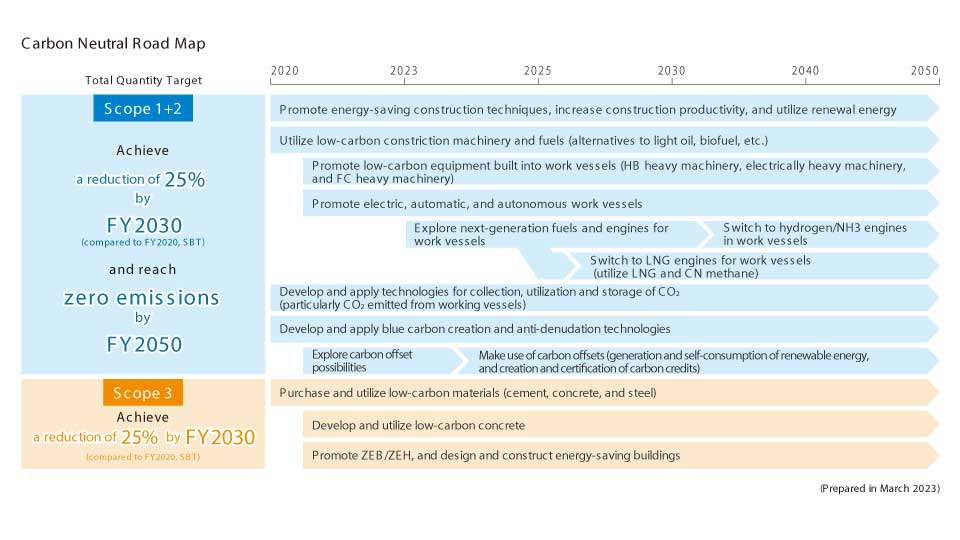
Results of Greenhouse Gas (GHG) Emissions
GHG Emissions of the TOA CORPORATION Group (by Scope)
Total GHG emissions of the TOA CORPORATION Group (by Scope) are shown below.
■Scope 1 + 2 and Scope 3 Emissions (t-CO₂)
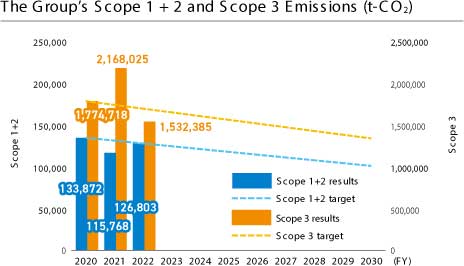
■Greenhouse Gas (GHG) Emissions (Consolidated)
| Item | Unit | FY2020 | FY2021 | FY2022 | Remarks |
|---|---|---|---|---|---|
| TOTAL | t-CO₂ | 1,908,590 | 2,283,793 | 1,659,188 | |
| Scope 1+2 | t-CO₂ | 133,872 | 115,768 | 126,803 | |
| Scope 1 | t-CO₂ | 128,628 | 111,428 | 124,134 | Direct greenhouse gas emissions by the reporting company itself |
| Scope 2 | t-CO₂ | 5,244 | 4,340 | 2,669 | Indirect emissions from the use of electricity, heat, or steam supplied by others |
| Scope 3 | t-CO₂ | 1,774,718 | 2,168,025 | 1,532,385 | Indirect emissions other than Scope 1 and Scope 2 (Emissions by others related to the company’s activities) |
* Third-party assurance has been received from Sustainability Accounting Co., Ltd.
* Scope 3 is the sum of categories 1,2,3,4,5,6,7,11,12,13.
■Emissions by Category (Scope3)
| Item | Unit | FY2020 | FY2021 | FY2022 | Remarks |
|---|---|---|---|---|---|
| Category 1 | t-CO₂ | 456,045 | 702,287 | 509,738 | Purchased goods and services |
| Category 2 | t-CO₂ | 24,010 | 7,889 | 11,779 | Capital goods |
| Category 3 | t-CO₂ | 19,467 | 17,496 | 19,977 | Fuel-and energy-related activities not included in the Scope 1 or 2 |
| Category 4 | t-CO₂ | 12,801 | 15,425 | 17,740 | Upstream transport and delivery |
| Category 5 | t-CO₂ | 604 | 891 | 814 | Waste generated in operations |
| Category 6 | t-CO₂ | 2,012 | 2,258 | 3,135 | Business Travel |
| Category 7 | t-CO₂ | 593 | 593 | 628 | Employee commuting |
| Category 11 | t-CO₂ | 1,214,676 | 1,364,287 | 902,834 | Use of sold products |
| Category 12 | t-CO₂ | 44,510 | 56,899 | 65,740 | End-of-life treatment of sold products |
| Category 13 | t-CO₂ | 0 | 0 | 0 | Downstream leased assets |
* Third-party assurance has been received from Sustainability Accounting Co., Ltd.
As for actual GHG emissions in FY2022, for Scope 1+2, energy conservation activities, introduction of load control systems (introduced on some of our work vessels), use of electric and hybrid heavy equipment (introduced mainly in construction equipment for land-based work), fuel efficiency improvement (use of alternative fuel to diesel oil and combustion-enhancing additives), and introduction of renewable energy were carried out, and these measures resulted in a 5.3% reduction compared to the target of 5% reduction from the base year (FY2020) emissions.
For Scope 3, we reduced emissions by 13.7% compared to the base year (FY2020) target of 5% reduction by introducing construction materials with low environmental impact and building relationships with suppliers to decarbonize through the value chain (e.g., promoting the introduction of ZEB).
These results enabled us to achieve our targets in all Scopes.
CO₂ emissions from domestic construction works
CO₂ emissions from our domestic construction works are calculated based on sampling surveys, and CO₂ emission intensity (per 100 million yen of construction sales) and total CO₂ emissions are shown in the figures below. This total amount of CO₂ emissions is equivalent to Scope 1+2 for domestic construction works.
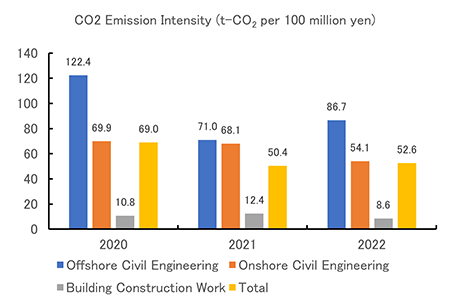
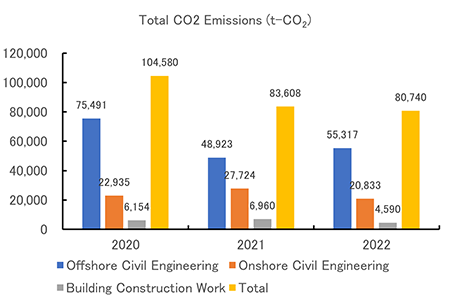
■CO₂ Emissions Intensity per Construction Sales
| Item | Unit | FY2020 | FY2021 | FY2022 | Remarks |
|---|---|---|---|---|---|
| Offshore Civil Engineering | t-CO₂/100 million yen | 122.4 | 71.0 | 86.7 | |
| Onshore Civil Engineering | t-CO₂/100 million yen | 69.9 | 68.1 | 54.1 | |
| Building Construction Work | t-CO₂/100 million yen | 10.8 | 12.4 | 8.6 | |
| Total | t-CO₂/100 million yen | 69.0 | 50.4 | 52.6 |
■Total CO₂ Emissions
| Item | Unit | FY2020 | FY2021 | FY2022 | Remarks |
|---|---|---|---|---|---|
| Offshore Civil Engineering | t-CO₂ | 75,491 | 48,923 | 55,317 | |
| Onshore Civil Engineering | t-CO₂ | 22,935 | 27,724 | 20,833 | |
| Building Construction Work | t-CO₂ | 6,154 | 6,960 | 4,590 | |
| Total | t-CO₂ | 104,580 | 83,608 | 80,740 |
In FY2022, both emissions intensity and total emissions in offshore civil engineering decreased by 27-29% compared to the base year (FY2020). In addition, both emissions intensity and total emissions for onshore civil engineering and building construction work also showed a downward trend. Thus, the reduction of emissions in offshore civil engineering had a significant impact, and the total emissions of all domestic construction projects in FY2022 were about 23% lower than in FY2020. This result contributed to the reduction and target achieved of the Group's Scope 1+2 emissions.
Energy Consumption
As input resources corresponding to the above GHG emissions, the total energy consumption of our group is shown below.
■Energy Consumption(MWh)
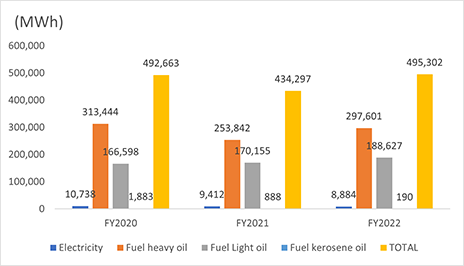
| Item | Unit | FY2020 | FY2021 | FY2022 | Remarks | |
|---|---|---|---|---|---|---|
| TOTAL | MWh | 492,663 | 434,297 | 495,302 | ||
| Electricity | MWh | 10,738 | 9,412 | 8,884 | ||
| Fuel | heavy oil | MWh | 313,444 | 253,842 | 297,601 | |
| Light oil | MWh | 166,598 | 170,155 | 188,627 | ||
| kerosene oil | MWh | 1,883 | 888 | 190 | ||
* Third-party assurance has been received from Sustainability Accounting Co., Ltd.
Third-party assurance
The above greenhouse gas emissions and energy consumption have been given assurance by an independent third-party.
>Independent Third-Party Assurance (PDF)

